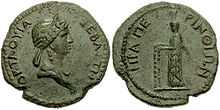Claudia Octavia
| Claudia Octavia | |
|---|---|
 | |
| Portrait head of Claudia Octavia, National Museum of Rome | |
| | |
| Tenure | 13 October AD 54 – 8 June AD 62 |
| Spouse | Nero |
| Full name | |
| Claudia Octavia | |
| House | Julio-Claudian Dynasty |
| Father | Claudius |
| Mother | Valeria Messalina |
| Born | late AD 39/early AD 40 Rome |
| Died | 8 June AD 62 Pandateria |
| Roman imperial dynasties | |||
| Julio-Claudian dynasty | |||
| Chronology | |||
| Augustus | 27 BC – 14 AD | ||
| Tiberius | 14–37 AD | ||
| Caligula | 37–41 AD | ||
| Claudius | 41–54 AD | ||
| Nero | 54–68 AD | ||
| Family | |||
| Gens Julia Gens Claudia Julio-Claudian family tree Category:Julio-Claudian dynasty | |||
| Succession | |||
| Preceded by Roman Republic |
Followed by Year of the Four Emperors | ||
Claudia Octavia (Classical Latin: CLAVDIA•OCTAVIA)[1] (late AD 39 or early AD 40 – 8 June AD 62) was an Empress of Rome. She was a great-niece of the Emperor Tiberius, paternal first cousin of the Emperor Caligula, daughter of the Emperor Claudius, and stepsister and first wife of the Emperor Nero. Asteroid 598 Octavia is named after her.
Life
Family
Octavia was the only daughter of the Emperor Claudius by his third marriage to his second cousin Valeria Messalina. She was named for her great-grandmother Octavia the Younger, the second eldest and full-blooded sister of the Emperor Augustus. Her elder half-sister was Claudia Antonia, Claudius's daughter through his second marriage to Aelia Paetina, and her full sibling was Britannicus, Claudius's son with Messalina.
Early life
She was born in Rome. As a young girl, her father betrothed her to future praetor Lucius Junius Silanus Torquatus, who was a descendant of Augustus.
Rise of Nero
Octavia's mother was executed in 48, for conspiring to murder her father. Claudius subsequently married his niece (and Octavia's first cousin) Agrippina the Younger. Nero (at that time known as Lucius Domitius Ahenobarbus) was Agrippina's son from her first marriage.
Agrippina, through her plotting and manipulating, ended the engagement between Octavia and Lucius Silanus and persuaded Claudius to adopt Nero as his son and heir and arranged for Octavia and Nero to marry on 9 June 53.
Life as empress
Claudius died on 13 October 54 and Nero acceded to the throne, possibly poisoning Octavia's full brother Britannicus in early 55 in order to do so. Tacitus states that from this moment Octavia became very unhappy, but learned to hide her affections and feelings around her husband and stepbrother. Octavia was caught up in the power struggles between Nero and his mother, which concluded when Nero murdered his mother in March 59.
Although she was admired as empress by the Roman citizen body, the marriage was unhappy. Octavia was an ‘aristocratic and virtuous wife' (in Tacitus's words), whereas Nero hated her and grew bored with her (according to both Tacitus and Suetonius), trying on several occasions to strangle her (according to Suetonius) and having affairs with a freedwoman called Claudia Acte and then with Poppaea Sabina. He excused this treatment of her when at one point his friends showed their concerns about it. When Poppaea became pregnant with Nero's child, Nero divorced Octavia, claiming she was barren, and married Poppaea twelve days after the divorce.
Banishment by Nero and Poppaea and death

Nero and Poppaea then banished Octavia to the island of Pandateria (modern Ventotene) on a false charge of adultery. When Octavia complained about this treatment, her maids were tortured to death.
Octavia's banishment became so unpopular that the citizens of Rome protested loudly, openly parading through the streets with statues of Octavia decked with flowers and calling for her return. Nero (badly frightened) nearly agreed to remarry Octavia, but instead he signed her death warrant.
A few days later, Octavia was bound and her veins were opened in a traditional Roman suicide ritual. She was suffocated in an exceedingly hot vapor bath. Octavia’s head was cut off and sent to Poppaea. Her death brought much sorrow to Rome. According to Suetonius, years later Nero would have nightmares about his mother and Octavia.
Ancestry
| Ancestors of Claudia Octavia | ||||||||||||||||||||||||||||||||||||||||||||||||||||||||||||||||||||||||||||||||||||||||||||||||||||||||||||||||||||||||||||||||||||||||||||||||||||||||||||||||||||||||||||||||||||||||||||||||||||||||||||||||||||||||||||||||||||||||||||||||||||||||||||||||||||||||||||||||||||||||||||||||||||||||||||||||||||||||||||||||||||||||||||||||||||||||||||||||||||||||||||||||||||||||||||||||||||||||||||||||||||||||||||||||||||||||||||||||||||||||||||||||||||||||||||||||||||||||||||||||||||||||||||||||||||||
|---|---|---|---|---|---|---|---|---|---|---|---|---|---|---|---|---|---|---|---|---|---|---|---|---|---|---|---|---|---|---|---|---|---|---|---|---|---|---|---|---|---|---|---|---|---|---|---|---|---|---|---|---|---|---|---|---|---|---|---|---|---|---|---|---|---|---|---|---|---|---|---|---|---|---|---|---|---|---|---|---|---|---|---|---|---|---|---|---|---|---|---|---|---|---|---|---|---|---|---|---|---|---|---|---|---|---|---|---|---|---|---|---|---|---|---|---|---|---|---|---|---|---|---|---|---|---|---|---|---|---|---|---|---|---|---|---|---|---|---|---|---|---|---|---|---|---|---|---|---|---|---|---|---|---|---|---|---|---|---|---|---|---|---|---|---|---|---|---|---|---|---|---|---|---|---|---|---|---|---|---|---|---|---|---|---|---|---|---|---|---|---|---|---|---|---|---|---|---|---|---|---|---|---|---|---|---|---|---|---|---|---|---|---|---|---|---|---|---|---|---|---|---|---|---|---|---|---|---|---|---|---|---|---|---|---|---|---|---|---|---|---|---|---|---|---|---|---|---|---|---|---|---|---|---|---|---|---|---|---|---|---|---|---|---|---|---|---|---|---|---|---|---|---|---|---|---|---|---|---|---|---|---|---|---|---|---|---|---|---|---|---|---|---|---|---|---|---|---|---|---|---|---|---|---|---|---|---|---|---|---|---|---|---|---|---|---|---|---|---|---|---|---|---|---|---|---|---|---|---|---|---|---|---|---|---|---|---|---|---|---|---|---|---|---|---|---|---|---|---|---|---|---|---|---|---|---|---|---|---|---|---|---|---|---|---|---|---|---|---|---|---|---|---|---|---|---|---|---|---|---|---|---|---|---|---|---|---|---|---|---|---|---|---|---|---|---|---|---|---|---|---|---|---|---|---|---|---|---|---|---|---|---|---|---|---|---|---|---|---|---|---|---|---|---|---|---|---|---|---|---|---|---|---|---|---|---|---|---|---|---|---|---|---|---|---|---|---|---|---|---|---|---|---|---|---|---|---|---|---|---|---|---|---|---|---|---|---|---|---|---|---|---|---|---|---|---|---|---|---|---|---|---|---|---|---|---|---|---|---|---|---|---|---|---|---|---|---|---|---|---|---|---|
<td rowspan="2>
| ||||||||||||||||||||||||||||||||||||||||||||||||||||||||||||||||||||||||||||||||||||||||||||||||||||||||||||||||||||||||||||||||||||||||||||||||||||||||||||||||||||||||||||||||||||||||||||||||||||||||||||||||||||||||||||||||||||||||||||||||||||||||||||||||||||||||||||||||||||||||||||||||||||||||||||||||||||||||||||||||||||||||||||||||||||||||||||||||||||||||||||||||||||||||||||||||||||||||||||||||||||||||||||||||||||||||||||||||||||||||||||||||||||||||||||||||||||||||||||||||||||||||||||||||||||||
In later fiction
The events of the divorce are dramatized in Octavia which is sometimes attributed to Seneca the Younger and, more recently, in Handel's lost opera Nero, Giovanni Francesco Busenello's opera L'incoronazione di Poppea (1643), Reinhard Keiser's opera Octavia (1705), and Vittorio Alfieri's tragedy Ottavia (1782). Octavia is also the subject of the massive German novel Die Römische Octavia (1677-1707) by Anthony Ulrich, Duke of Brunswick-Wolfenbüttel, and a character in Robert Graves's novel Claudius the God (the sequel to I, Claudius) and the television series I, Claudius.
Notes
- ↑ E. Groag, A. Stein, L. Petersen – e.a. (edd.), Prosopographia Imperii Romani saeculi I, II et III (PIR), Berlin, 1933 – C 1110
Sources
- Suetonius – The Twelve Caesars – Claudius and Nero.
- Tacitus – The Annals of Imperial Rome.
References
| Wikimedia Commons has media related to Claudia Octavia. |
- E. Groag, A. Stein, L. Petersen – e.a. (edd.), Prosopographia Imperii Romani saeculi I, II et III, Berlin, 1933 – . (PIR2)
- Levick, Barbara, Claudius. Yale University Press, New Haven, 1990.
- Barrett, Anthony A., Agrippina: Sex, Power and Politics in the Early Roman Empire. Yale University Press, New Haven, 1996.
| Royal titles | ||
|---|---|---|
| Preceded by Agrippina the Younger |
Empress of Rome 54–62 |
Succeeded by Poppaea Sabina |